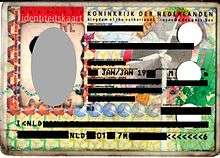Dutch identity card
| Dutch identity card (Nederlandse identiteitskaart) | |
|---|---|
| Issued by |
|
| Valid in |
|
| Type of document |
Identity card, travel document for passport in the listed countries |

The Dutch identity card (Dutch: Nederlandse identiteitskaart) is an official non-compulsory identity document issued to Dutch nationals in the European part of the Netherlands and certain diplomatic missions. It has similar dimensions and structure as that of a regular bank card.[1]
Use
All Dutch citizens from the age of 14 are required to be able to show a valid identity document when the police or other enforcement officers ask for identification.[2] The identity card is commonly used for this purpose, but other identity documents such as a passport or driving licence may be used instead.
The Dutch identity card is also a valid means of personal identification in a number of countries outside the Netherlands and may be used as a travel document in those countries in place of a Dutch passport.
Identity information
A Dutch identity card includes the following information about the holder and the document (with fields in Dutch and English ):[3]
- Nationality: Nederlandse (Dutch)
- Document number
- Full name, including surname and all given names
- Photograph (both printed and processed to watermark)
- Date of birth
- Place of birth
- Height
- Sex
- Personal number
- Authority (the authority who issued the concerning identity card, commonly the mayor of the municipality of residence; for example "Burgemeester van Utrecht")
- Date of issue
- Date of expiry (normally 10 years after the date of issue)
- Signature
As of 26 August 2006, newly issued identity cards are provided with a chip containing (among others) the photograph, full name, date of birth, sex, document number, personal number, date of expiry,[4] and since 28 June 2009 also two fingerprints of the holder.[5] The chip has been included due to European regulations.
Validity
The Dutch identity card is a valid travel document within all of Europe (except Belarus, Russia and Ukraine) as well as Georgia, Turkey and on organized tours to Jordan (through Aqaba airport) and Tunisia. [6][7]
Validity in EU/EFTA states is based on membership of the European Union, while validity in Turkey is based on the "European Agreement on Regulations governing the Movement of Persons between Member States of the Council of Europe".[8]
Since the document is defined within the Dutch Passport Law (Paspoortwet) as a "travel document of the European part of the Netherlands" rather than a "travel document of the Kingdom",[9] this identity card is not issued or valid in the ABC islands or the SSS islands.[10]
An identity card is normally valid for a period of 10 years.
European identity card

Before the introduction of the Dutch identity card (1 October 2001) on creditcard-format, an ID2-format European identity card was issued.[11] This card was machine-readable as well and was valid for the same group of countries (but not for 11 out of 12 EU countries which acceded in 2004 and 2007).[12] The card contained also information on the bearer's address and had fields in English, Dutch and French. After introduction of the Dutch identity card, existing European identity cards remained valid until expiry.
See also
References
- ↑ "Identity card". Dutch Government. 24 September 2007. Retrieved 11 May 2010.
- ↑ "Identificatieplicht" (in Dutch). Dutch Government. Retrieved 4 August 2013.
- ↑ "NLD-BO-02001". Council of the European Union. Retrieved 9 May 2010.
- ↑ "Wat is een elektronisch reisdocument en welke gegevens bevat de chip hierin?" (in Dutch). Dutch Government. Retrieved 10 May 2010.
- ↑ "Invoering vingerafdrukken". Ministry of the Interior and Kingdom Relations (Netherlands) (in Dutch). 26 June 2009. Retrieved 22 March 2010.
- ↑ "Dutch passport, ID card". Ministry of Foreign Affairs (Netherlands). Retrieved 15 May 2010.
- ↑ "Citizens of which countries enter the Republic of Albania without a visa". Ministry of Foreign Affairs (Albania). Retrieved 18 August 2010.
"Bosnië-Herzegovina: reis en verblijf". Ministry of Economic Affairs, Agriculture and Innovation (Netherlands) (in Dutch). Retrieved 19 November 2010.
"Information for foreign citizens". Ministry of Foreign Affairs (Macedonia). Retrieved 10 June 2010.
"Overview of visa regimes for foreign citizens". Ministry of Foreign Affairs (Montenegro). Retrieved 16 August 2010.
"Consular Affairs". Ministry of Foreign Affairs (Serbia). Retrieved 5 October 2010.
"Vatican City: Visa and Passport Requirements". World Travel Guide. Retrieved 6 August 2011. - ↑ "European Agreement on Regulations governing the Movement of Persons between Member States of the Council of Europe; CETS No.: 025". Council of Europe. Retrieved 15 May 2010.
- ↑ "Paspoortwet". Dutch Government (in Dutch). Retrieved 2 December 2010.
- ↑ "De gevolgen van de staatkundige veranderingen". Ministry of the Interior and Kingdom Relations (Netherlands) (in Dutch). Retrieved 2 December 2010.
- ↑ "Antwoorden op kamervragen over rijbewijzen als identiteitsbewijs". Ministry of the Interior and Kingdom Relations (Netherlands) (in Dutch). 19 December 2006. Retrieved 18 August 2010.
- ↑ "European identity card (back)". Ministry of the Interior and Kingdom Relations (Netherlands). 25 June 2009. Retrieved 11 May 2010.